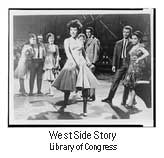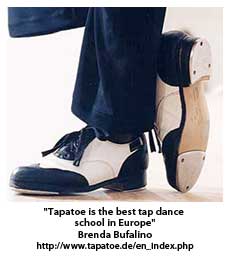When I was asked to write a piece on dance in film by Jim Searles, well, asked isn’t really the right word, more like, arm twisted, I thought to myself, “Sure. Why not?! Piece of cake!” Then I got to thinking about what I wanted to say about dance in film, and realized, that it wasn’t going to be as easy as I thought.

There is a rich and full history of dance in film. It seems that since film came into existence, filmmakers have wanted to try to capture the ethereal gracefulness and elusiveness that is what makes up a dancer, be they male or female. Some of the earliest films of dance are of the elusive Anna Pavlova. While the sound is virtually nonexistent, and the speed that the film plays at is not what would be a true speed for her to dance at, there she is, preserved for eternity on film for all the aspiring ballerinas of the world to view forever. A direct link to the glory days that were the 1890’s in Russia when Tchaikovsky composed his standards and they were performed for the first time for the Tsars and Tsarinas; Swan Lake, The Nutcracker, and The Sleeping Beauty.
Now, you may say to yourself, well, what does that have to do with contemporary filmmaking. Just hang on…I’ll show you.
As movie technology progressed and sound was added to film, it made the possibility and ability to capture dance, even more accurately onto film. Some of the most spectacularly staged, and I do mean staged, not choreographed, numbers came out of The Ziegfeld Follies movies and the Busby Berkeley numbers. Don’t get me wrong, those are absolutely marvelous pieces, the massive stage productions, but, choreographic works of art? Well, that is this dancer’s opinion. I love watching them as much as the next, but I wouldn’t put them in the same category as say, Jerome Robbins “West Side Story”.
Anyway, back to the pre-WW II movies…Fred Astaire and Ginger Rogers…I still have to laugh when I hear what the original critique of his screen test was:
“Can sing and dance a little”. Talk about your understatement of the year. (But, he wasn’t the last one to be underestimated, and I’ll elaborate on that person at a later date.) I digress. Fred and Ginger are still the epitome of grace, style, and poise. While their films aren’t necessarily Oscar caliber, the influence that they have had on society, from their first movies, all the way through 2003 is astounding. While Fred never really actually owned any of the Fred Astaire Ballroom Schools, having sold his name, they are still in existence, and competitive ballroom dance, commonly called dancesport now, is very common, and the Olympic Committees are being lobbied to have it included as an actual sport. I wonder what Fred would think about that?
Now, I did mention something about that Russian composer, Tchaikovsky, and promised that I would tie in his ballets from the 1890’s into movies; so, I guess I’d better get about doing it. Well, ballets have been filmed since film was able to capture ballerinas and danseurs, male dancers, onto film. If one were to do an Internet search for ballets on video format, there would be a plethora of available titles, ranging from the aforementioned classics, to Agnes De Mille’s Rodeo, to Antony Tudorfs Jardin Aux Lilas (The Lilac Garden), to Billboards, a Joffrey Ballet piece where that company invited varying choreographers to choreograph the music of the Artist Formerly Known As Prince. What few people know is that there are excerpts of many of the great ballets worked into contemporary film.
Most people have heard of the movie, and actually seen the movie “Bye, Bye, Birdie”, that wonderful salute to pop culture and the generation gap still exists between high-school teens and their parents. (Some things never change!) The movie, in and of itself, has some of the best choreography, especially the number that occurs in the Shriners’ meeting in the basement of the bar. What many people don’t realize is that the ballet scene, towards the end of the movie, is actually The Rose Adagio from the classic ballet “Sleeping Beauty”. Many people have actually thought that that piece was made up just for the movie. It wasn’t. That is a fairly accurate interpretation of what the original choreography is supposed to have been. Without that scene, where Dick Van Dyke slips the Russian conductor a speed up drug in his milk, there wouldn’t be that great scene in the movie where he speeds up the tempo of the music and the poor ballet dancers attempt, in vain, to keep up with the ever increasing tempo of the music.
So, we have here, an 1890’s ballet, one of the greatest, encroaching upon pop culture and almost preventing the “One Last Kiss” song from being sung on the Ed Sullivan Show. The original filmmakers had the right idea about attempting to capture dance on film. It is the only way to capture the elusiveness that is a dance performance, but I don’t think that they were aware that their attempts to capture beauty and grace and to preserve it for posterity would have led to one of the most hilarious scenes in a movie.
DANCE IN FILM PART II by Amie Ferrante
Since last I wrote, I have given what I want to write about this month, great thought. I am fascinated by connections, always have been always will be. How and why things happened in the past and how they affect the future and the present is truly fascinating to me. What would appear to be a series of unconnected events can link up, meld, blend, and, voila! A new dance form/art is born. Then, we have this “new” medium, film, to capture its childhood and document its teen years, and capture its adulthood.
I know that some of you are wondering what “new” dance form I am talking about. Have I got your attention? Well, the “new” dance form is tap dancing. While it may seem as if it has been around for years, it actually hasn’t. Its forerunners have been around for hundreds of years, and that is the connection that I want to explore now, the connection of tap dance, to the past and film.

I’ll start by stating a few “givens”. The United States, amongst other countries, imported slaves from Africa for years. When Africans were brought here, at first, they were allowed to keep their drums and use them. After the Cato slave rebellion, when slaves “called” to other slaves to join them along the Atlantic coastline, drums were confiscated, as the slave owners were afraid that the slaves would use the technique of “talking” drums again, to organize another revolt. The Africans, once their drums were taken away, turned to stamping out the ancient tribal rhythms in the dirt, so as not to lose this important part of their heritage and preserve what little original identity they could.
At the same time, the United States was also importing indentured servants from Ireland and Scotland. These indentured servants brought with them the “hard shoe” dancing from their native lands. Now, it isn’t quite clear how the two forms of dance met and blended, specifically, but it is clear that, at some point, they did, and the result was tap dance. When tap dance first emerged is questionable. Some think it emerged as late as the 1890’s, others as early as the 1830’s. Unfortunately, there is no filmed documentation of its emergence, and, as it wasn’t necessarily an upper class dance form; there isn’t much documentation of its emergence.
What we do have filmed documentation of are some very interesting mutations and morphings that tap dance has gone through. Previous to “talkie” movies, dance was not that interesting to film, as there wasn’t any music available, other than the accompaniment provided by the movie house pianist or organist… okay, and the rare movie house that actually had its own “house” orchestra.
Once sound was introduced, a whole new world of filming was possible, not to mention a whole new ability to stage fantastic, fabulous productions, each one more elaborate than the last, in an attempt to vie for the customer’s dollar.
Who can forget the Busby Berkeley movies, the elaborate sets, the gorgeous dancing girls, and the innovative use of staircases to create depth to the scenes? Then, there are for me, the totally forgettable numbers where some choreographer had the bright idea to put some taps onto pointe shoes. For the reader that isn’t familiar with ballet, pointe shoes are designed to operate, optimally, when the leg is rotated and “turned out” from the hip. Tap dance is not necessarily designed to work from a turned out position, although there are some steps that involve a little bit of “turn out”, but not to the extent that is necessary to dance en pointe. While an interesting novelty, it did little to further the art forms of either dance, or film.
As film progressed, many great tap dancers, amongst other dancers, emerged and started to develop and shape the art form of tap dance. Fred Astaire, while mostly known for his skill as a tap dancer, actually did much to develop filming techniques with his innovative choreography and insistence on not “breaking” the scenes during filming. He insisted that a number be filmed all the way through, no stopping and starting, thus challenging the camera men and film crews to extend their knowledge and skill at getting the shot right the first time. There are many stories of his partner. Ginger Rogers, coming out of shoots with blood on her shoes from her feet, as they had to dance scenes over and over until they were correct.
Fred Astaire also innovated the use of props, in tap dancing. Who can forget that marvelous scene where he dances round a room, all while seeming to stand perpendicular to the floor, in Royal Wedding? The dances with a hat rack? Drums and drumsticks, which contemporary dancers continue to imitate to this day?
One of my favorite tap dances of all time is from the Ziegfeld Follies of 1946, directed by Vincent Minelli where Gene Kelly and Fred Astaire dance through their lives. It is the only time the two great tappers actually danced together, so, if you have yet to see it, I would urge you to rent it this weekend.
Then there are the Nicholas Brothers. Wonderful innovators in choreography. The dance with the stairs, where they simply leap over each other and land in the splits? Brilliance, sheer brilliance. I had the infinite pleasure and privilege of taking a few classes with Harold Nicholas, a few years back.After class, I asked him who did their choreography and how they came up with the idea for jumping over each other on the way down the stairs. Believe it or not, he told me that they were simply trying to outdo each other, and, simply kept on going with it, once one had done it in rehearsal.
Again, mistakes, chance meetings, happenstance – one never knows where things being viewed came from, what their past is, what their future is. The next time you sit and watch one of the great tap pieces on film, stop and think about tribal drumming from Africa, or, maybe the more obvious, indentured Scottish or Irish servants, and you can see the history of this great art form.
